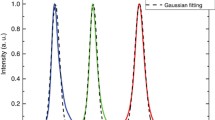Abstract
Here, we introduce a selective photo-recycling scheme for organic light-emitting diode (OLED) displays. The conventional photo-recycling method, which uses a recycling film named DBEF, diminishes the ambient contrast ratio of the OLED display, so it is not suitable for display applications. The selective recycling scheme, which uses a cholesteric liquid crystal (CLC) layer that recycles light only in a specific spectral range, can minimize the deterioration of the ambient contrast ratio while improving the photo-efficiency. We found that the aperture ratio of the OLED display influences the recycling efficiency significantly, and that a thin CLC layer diminishes the ambient contrast ratio less than a thick CLC layer while it still recycles the emitted light. By recycling the blue spectral range, one can improve the lifetime of blue OLE material, which has the shortest lifetime, or reduce the size of the blue pixel, which has the largest size among red, green, and blue pixels.





Similar content being viewed by others
References
S.R. Forrest, The path to ubiquitous and low-cost organic electronic appliances on plastic. Nature 428, 911–918 (2004)
P. Gorrn, M. Sander et al., Towards see-through displays: fully transparent thin-film transistors driving transparent organic light-emitting diodes. Adv. Mater. 18, 738–741 (2006)
H. Aziz et al., Degradation mechanism of small molecule-based organic light-emitting devices. Science 283, 1900 (1999)
C.J. Tonzolar, A.P. Kulkarni, A.P. Gifford, W. Kaminsky, S.A. Jenekhe, Blue-light-emitting oligoquinolines: synthesis, properties, and high-efficiency blue-light-emitting diode. Adv. Funct. Mater. 17, 863–874 (2007)
A. Dodabalapur, L.J. Rothberg, T.M. Miller, Color variation with electroluminescent organic semiconductors in multimode resonant cavities. Appl. Phys. Lett. 65, 2308–2310 (1994)
F.S. Juang, L.H. Laih, C.J. Lin, Y.J. Hus, Angular dependence of the sharply directed emission in organic light emitting diodes with a microcavity structure. Jpn. J. Appl. Phys. 41, 2787–2789 (2002)
M.A. Baldo, D.F. O’Brien, Excitonic singlet-triplet ratio in a semiconducting organic thin film. Phys. Rev. B 60, 14422–14428 (1999)
M.H. Lu, J.C. Sturm, Optimization of external coupling and light emission in organic light-emitting devices: modeling and experiment. J. Appl. Phys. 91, 595 (2002)
S.H. Cho, J.R. Oh et al., Highly efficient phosphor-converted white organic light-emitting diodes with moderate microcavity and light-recycling filters. Opt. Express 18(2), 1099 (2010)
S.M. Jeong et al., Highly circularly polarized electroluminescence from organic light-emitting diodes with wide-band reflective polymeric cholesteric liquid crystal films. Appl. Phys. Lett. 90, 211106 (2007)
B. Park, Y.H. Huh, H.G. Jeon, Polarized electroluminescence from organic light-emitting devices using photon recycling. Opt. Express 18(19), 19824 (2010)
F. Rahadian, K. Imai, I. Fujieda, Comparative study of organic light emitting diode efficiency enhancement by the use of optical films. Opt. Eng. 46, 124001 (2007)
B.C. Krummacher, M.K. Mathai, V. Chong, S.A. Choulis, F. So, General method to evaluate substrate surface modification techniques for light extraction enhancement of organic light emitting diodes. J. Appl. Phys. 100, 054702 (2006)
M.F. Weber, C.A. Stover, L.R. Gilbert, T.J. Nevitt, A.J. Ouderkirk, Giant birefringent optics in multilayer polymer mirrors. Science 287(5462), 2451–2456 (2000) (and references therein)
J.D. Joannopoulos, P.R. Villeneuve, S. Fan, Photonic crystal: putting a new twist on light. Nature 386, 143–149 (1997)
H. De Vries, Rotatory power and other optical properties of certain liquid crystals. Acta Crystallogr. 4, 219–226 (1951)
S.A. Van Slyke, C.H. Chen, C.W. Tang, Organic electroluminescent devices with improved stability. Appl. Phys. Lett. 69(15), 2160–2162 (1996)
P. Wellmann, M. Hofmann, O. Zeika et al., High-efficiency p-i-n organic light-emitting diodes with long lifetime. J. Soc. Inf. Disp. 13(5), 393–397 (2005)
Author information
Authors and Affiliations
Corresponding author
Rights and permissions
About this article
Cite this article
Lee, E., Song, JK. High efficiency organic light-emitting display using selective spectral photo-recycling. Appl. Phys. A 109, 431–436 (2012). https://doi.org/10.1007/s00339-012-7042-z
Received:
Accepted:
Published:
Issue Date:
DOI: https://doi.org/10.1007/s00339-012-7042-z




